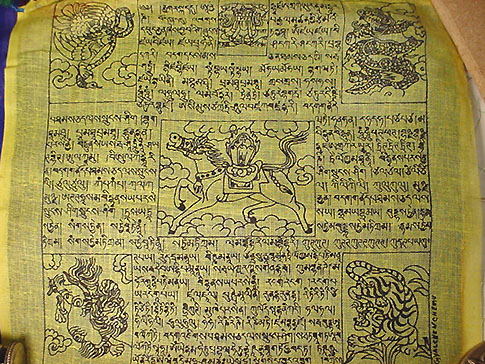Prayer flags: Difference between revisions
No edit summary |
No edit summary |
||
| Line 7: | Line 7: | ||
Tibetan Buddhists for centuries have planted these flags outside their homes and places of spiritual practice for the wind to carry the beneficent vibrations across the countryside. | Tibetan Buddhists for centuries have planted these flags outside their homes and places of spiritual practice for the wind to carry the beneficent vibrations across the countryside. | ||
Prayer flags may be placed either inside of a building to increase the spiritual atmosphere or outdoors where the wind can carry their prayers. Traditionally, they are fastened to eaves or sewn onto ropes to be displayed horizontally or they are fastened to wooden poles for vertical display. Sets of five color flags | Prayer flags may be placed either inside of a building to increase the spiritual atmosphere or outdoors where the wind can carry their prayers. Traditionally, they are fastened to eaves or sewn onto ropes to be displayed horizontally or they are fastened to wooden poles for vertical display. Sets of five color flags are displayed in the colors: yellow, green, red, white, blue. These colors represent the elements: earth, water, fire, wind, space. | ||
===Windhorse prayer flags=== | ===Windhorse prayer flags=== | ||
Revision as of 16:15, 20 July 2007

Prayer flags - (Tib. dar cho; Wyl. dar lcog) are displayed in the Tibetan Buddhist tradition to generate merit and increase one's life force.
Prayer flags are inscribed with auspicious symbols, invocations, prayers, and mantras. Some flags bear protectors and enlightened beings. The symbols on the flags typically represent aspects of enlightened mind, i.e. compassion, perfect action, fearlessness, etc.
Tibetan Buddhists for centuries have planted these flags outside their homes and places of spiritual practice for the wind to carry the beneficent vibrations across the countryside.
Prayer flags may be placed either inside of a building to increase the spiritual atmosphere or outdoors where the wind can carry their prayers. Traditionally, they are fastened to eaves or sewn onto ropes to be displayed horizontally or they are fastened to wooden poles for vertical display. Sets of five color flags are displayed in the colors: yellow, green, red, white, blue. These colors represent the elements: earth, water, fire, wind, space.
Windhorse prayer flags
The windhorse prayer flags typically display a tiger, a snow lion, a garuda, and a dragon, (the four dignities) with a windhorse in the center around which is written the mantra, "May the horse of good fortune run fast and increase the power of life, influence, fortune, wealth, health, and so forth." These words are then drawn into the world by the actual wind, and our minds energy, and radiate goodness outwards.
The symbols in the windhorse prayer flag are arranged as follows: Upper left is the Kyung, or Garuda, the destroyer of evil. Upper right is the Druk or dragon, whose roar cuts through the fog of ignorance, the prime obstacle on the path to enlightenment. Lower left is the Senge or snowlion, a symbol of bravery. Lower right is the Tag or tiger, who depicts strength and confidence which one must possess to follow the path and become one with the Dharma.